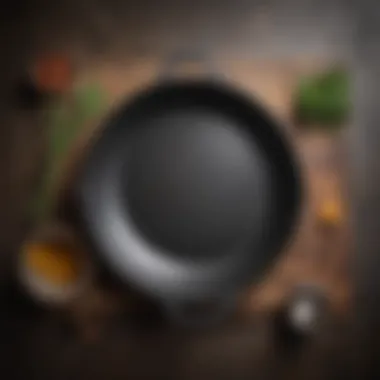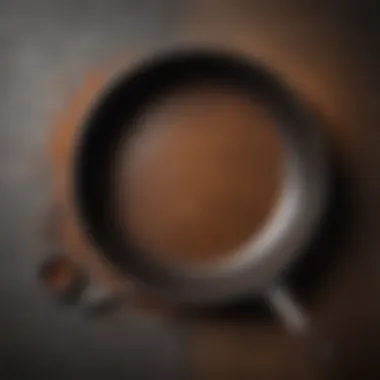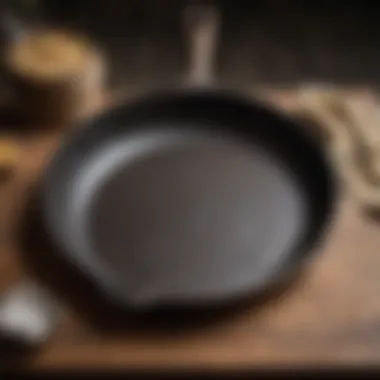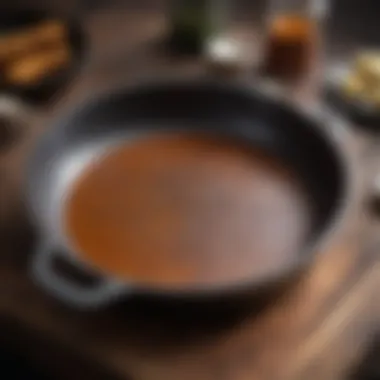Effective Techniques for Removing Rust from Cast Iron


Intro
Cast iron skillets are renowned for their durability and superior cooking properties. However, they are not immune to rust. Understanding the nature of rust formation on these skillets is essential to apply the right cleaning methods and techniques.
Rust typically forms due to moisture and exposure to air. When a cast iron skillet is not properly seasoned or stored, the iron reacts with oxygen and water, resulting in rust. This article will not only address effective cleaning techniques but also discuss preventive steps that can keep your skillet in prime condition. By following these guidelines, you can ensure your cast iron skillet continues to be a valuable tool in your kitchen for years to come.
Maintaining a cast iron skillet is a skill that can enhance not only your cooking experience but also your culinary results.
Understanding Cast Iron Cookware
Cast iron cookware holds a revered place in kitchens around the world. The significance of understanding cast iron cookware lies not just in its history, but also in the reverence it commands from culinary enthusiasts. This section examines the material composition and the many benefits of using cast iron, shedding light on why it is a critical tool in both home and professional kitchens.
Material Composition
Cast iron skillets are primarily made from iron, with a small percentage of carbon mixed into the material. This composition provides cast iron with its characteristic durability and heat retention. The manufacturing process of cast iron involves pouring molten iron into molds, which creates solid cookware free from seams or joints. This construction adds to the strength, allowing these skillets to withstand high temperatures.
The seasoning process, using oils, creates a non-stick surface and aids in rust prevention. Ideally, a well-seasoned skillet develops a natural patina over time, enhancing cooking performance. Understanding this material composition is fundamental, as it influences care practices and informs users on how to properly maintain their cookware for long-lasting use.
Benefits of Using Cast Iron
Utilizing cast iron in cooking presents multiple advantages:
- Heat Retention: Cast iron skillets retain heat efficiently, which makes them perfect for a variety of cooking techniques such as searing and frying.
- Versatility: They can be used on the stovetop, in the oven, or even over a campfire, adapting to various cooking methods and environments.
- Natural Non-Stick Surface: With proper seasoning, cast iron has a non-stick property that develops over time, making it easier to cook food without sticking.
- Fortified Nutrition: Cooking with cast iron can introduce small amounts of iron into food, which is beneficial for those needing to boost their iron intake.
- Durable and Long-Lasting: If properly cared for, cast iron cookware can last for generations.
"A well-cared-for cast iron skillet is like a prized possession, earning its place in every kitchen."
The Science of Rust Formation
Understanding rust formation is crucial for those who want to maintain cast iron skillets. Rust is not merely an aesthetic issue; it can significantly impact the performance and longevity of your cookware. When cast iron rusts, it loses its non-stick properties, becomes difficult to clean, and may even affect the taste of food.
The rusting process involves oxidation, which comprises a series of chemical reactions between iron, moisture, and oxygen. This section will delve deeper into the nuances of this process and its environmental triggers.
Chemical Reaction Overview
Rust is primarily composed of iron oxide, occurring when iron reacts with oxygen in the presence of moisture. The chemical equation can be simplified as follows:
[ 4Fe + 3O_2 + 6H_2O \rightarrow 4Fe(OH)_3 \rightarrow 2Fe_2O_3 \cdot 3H_2O ]\
This equation illustrates how iron reacts with oxygen and water to form hydrated iron(III) oxide, commonly known as rust. Once rust forms, it compromises the structural integrity of the cast iron surface. Continuous exposure to moisture exacerbates this condition, leading to more significant surface corrosion.
Moreover, even the slightest scratch in the seasoning layer can expose bare iron, accelerating rust formation. Thus, understanding this chemical reaction is integral when tackling rust issues.
Environmental Factors Contributing to Rust
Several external factors play a pivotal role in facilitating rust formation on cast iron cookware. Here are some key contributors:
- Humidity: High humidity levels can create a conducive environment for rust. When moisture accumulates on the skillet's surface, the right conditions for oxidation arise.
- Temperature: Fluctuations in temperature can lead to condensation, especially when a cold skillet meets warm air. This condensation creates moisture, again promoting the oxidation process.
- Exposure to Water: Direct exposure to water, whether through washing or accidental spills, can initiate rust formation. It is essential to ensure that cast iron skillets are well-dried after washing.
- Stored Environment: A damp kitchen or storage area can result in increased moisture retention on cookware. Keeping cast iron skillets in a dry place minimizes rust risk.
By recognizing these factors, users can take steps to mitigate rust formation and prolong the life of their cast iron skillets.
Initial Inspection of the Skillet
The initial inspection of a cast iron skillet is a crucial step in the rust removal process. Understanding the condition of the skillet allows you to determine appropriate cleaning methods and prevent further damage. By conducting a thorough inspection, you can identify the extent of rust and how it impacts the cooking surface. Not all rust is the same, and knowing how to assess your skillet will lead to better maintenance practices.


Identifying Rust Levels
When inspecting for rust, it is important to understand the levels, as this influences your cleaning approach. Rust can manifest in several ways:
- Light Surface Rust: This is usually a fine, powdery residue that can often be wiped away with a cloth. It indicates that the skillet has not been properly seasoned or has been exposed to moisture.
- Moderate Rust: This level shows signs of discoloration, along with rough textures. The skillet may develop pitting, indicating a deeper issue that needs addressing.
- Severe Rust: This is characterized by deep corrosion and extensive flaking. It compromises the integrity of the skillet and usually requires intense cleaning efforts.
To accurately identify these rust levels, it’s helpful to run your fingers over the surface to feel for roughness or flaking. Visually inspecting the skillet can also reveal patches of red or brown spots, signifying rust formation.
Types of Rust Damage
Different types of rust damage may occur on a cast iron skillet, and knowing the types can help in deciding on cleaning techniques:
- Surface Rust: This affects only the top layer, making it relatively easy to remove with light scrubbing or abrasives. Surface rust does not typically impact the cooking performance.
- Scaly Rust: This type occurs when rust begins to flake off in larger pieces. It indicates that moisture has penetrated deeper, and the skillet’s seasoning has failed. Removing these scales can be tedious.
- Pitting: When the surface develops small, crater-like indentations. Pitting can be worrisome as it affects the skillet’s non-stick qualities and can become a breeding ground for more rust.
"Understanding the different types of rust damage can significantly inform your cleaning strategy and prolong the life of your skillet."
Overall, a careful inspection enables users to take proactive measures in rust prevention and maintains the functionality of the cast iron skillet. Keep in mind the condition of your skillet is directly related to its performance in the kitchen.
Essential Tools and Materials
In the process of restoring a cast iron skillet, having the right tools and materials is essential. These items contribute not only to a more effective cleaning process but also aid in maintaining the skillet's longevity after the rust has been removed. Appropriate equipment can make the difference between a frustrating experience and a successful restoration.
By using designated tools, users can avoid damaging the skillet further. For example, using the wrong type of scrubber can scratch the seasoned surface or exacerbate rust issues. Thus, knowing what tools and materials to use is crucial.
Cleaning Tools Overview
When it comes to cleaning a cast iron skillet, several tools stand out as particularly effective in tackling rust:
- Steel Wool: This is one of the most favored tools due to its abrasiveness. It helps in scrubbing off rust without being excessively damaging, provided that users choose the appropriate grade.
- Scrub Brushes: A durable scrub brush can be ideal for less aggressive cleaning. They can reach the edges and contours of the skillet, effectively dislodging rust from areas where steel wool might struggle.
- Plastic Scrapers: These are useful for gently scraping off rust without scratching the skillet surface. They are often recommended for delicate cleaning tasks.
- Microfiber Cloths: After the rust removal process, using a microfiber cloth helps to dry the skillet effectively and is gentle on the surface while also preparing it for seasoning later on.
It's also worth noting that the choice of tools can vary based on personal preference and the degree of rust damage. Using a combination of tools can be beneficial depending on the situation.
Recommended Cleaning Agents
Selecting effective cleaning agents complements the physical tools used in rust removal. Some of the most effective cleaning agents include:
- Vinegar: The acetic acid in vinegar breaks down rust efficiently. It is a natural solution that many prefer over chemical alternatives.
- Baking Soda: When mixed with water, baking soda forms a paste that can be applied to rust-stained sections. It acts as a gentle abrasive, assisting in rust removal without harming the skillet.
- Salt: It can be used with vinegar or water to create a paste. This helps in scrubbing off stubborn rust without causing scratches.
- Commercial Rust Removers: While less common, some users opt for specialized rust-removal products. These can be effective but should be checked for compatibility with cast iron and the environment.
Choosing the right cleaning agents is critical in ensuring that the rust does not return post-cleaning. Proper application and combination of these agents with the aforementioned tools will significantly enhance the cleaning process, making it more efficient and effective.
The quality of the tools and materials used can influence both the cleaning process and the longevity of the cast iron skillet. Invest time in selecting the right options.
Step-by-Step Rust Removal Techniques
Rust removal from cast iron skillets is essential to restore their cooking surface and maintain their longevity. Ignoring rust not only diminishes the skillet's performance but can also affect the taste and quality of your food. Understanding practical techniques for rust removal empowers users to act swiftly when signs of deterioration appear. This section will discuss specific methods, considering effectiveness and accessibility, enabling readers to choose the approach that best suits their needs.
Using Steel Wool
Steel wool is a robust and efficient tool for tackling rust on cast iron skillets. Its abrasive nature makes it suitable for removing stubborn rust without damaging the underlying cast iron. You should begin with a medium grit steel wool to assess the severity of the rust. Applying a little bit of elbow grease, scrub the affected areas in small, circular motions. It's important to maintain a steady pressure, ensuring not to press too hard, as it could create scratches on the skillet's surface.
After removing the rust, clean the skillet with warm, soapy water and dry it immediately to prevent any moisture that could lead to new rust formation. Make sure to season the skillet afterward to protect it from future corrosion.
Applying Baking Soda Paste
Baking soda can be an effective and gentle rust removal method for cast iron skillets. This approach is particularly useful for light rust stains. To create a paste, mix baking soda with water until it reaches a thick consistency. Apply this paste directly onto the rust spots and allow it to sit for about 15-30 minutes. The alkaline properties of baking soda will help to lift rust from the skillet.


Once the time elapses, gently scrub the surface with a cloth or sponge. Rinse with warm water and dry thoroughly. Following this method won’t only remove rust but also provides a gentle cleaning solution that’s less harsh on the skillet, making it ideal for routine maintenance.
Utilizing Vinegar Solutions
Vinegar is a readily available household item that can aid in rust removal due to its acidic nature. To employ this technique, create a vinegar soak by submerging the skillet in a mixture of equal parts vinegar and water. Allow the skillet to sit for approximately one hour. The acid in the vinegar dissolves the rust, making it easier to scrub away afterward.
After the soaking, scrub the skillet with a non-abrasive pad to further eliminate the rust. It is crucial to rinse the skillet thoroughly afterward as vinegar residue can alter the flavor of your food. Dry immediately and apply a layer of oil to ensure the surface is seasoned and protected.
Employing Salt Grains
Salt acts as a mild abrasive, making it a suitable alternative for rust removal on cast iron skillets. To use this method, sprinkle coarsely ground salt over the rusted areas. Then, using a soft sponge or cloth, scrub the salt into the rust. The texture of the salt helps lift the rust without scratching the skillet.
Salt is particularly effective when combined with other elements, such as lemon juice or even vinegar, for enhanced acidic action. After scrubbing, rinse the skillet, dry it completely, and season it. This method is straightforward and utilizes common kitchen ingredients, making it an accessible option for many.
Post-Cleaning Maintenance
After successfully removing rust from your cast iron skillet, the next step is critical: post-cleaning maintenance. This stage is essential for ensuring the longevity of your cookware and preventing future rust development. The steps taken after cleaning are just as vital as those during the cleaning process itself. Maintaining your skillet properly can enhance its cooking performance and extend its lifespan significantly.
Seasoning the Skillet
Seasoning your cast iron skillet is an indispensable part of post-cleaning care. This process involves applying a layer of oil to the skillet and heating it, creating a protective coating. Not only does seasoning prevent rust, but it also provides a non-stick surface for cooking.
- Choose the Right Oil: Use oils with high smoke points like vegetable oil or grapeseed oil. These help create a durable layer.
- Clean the Skillet: Before applying the oil, ensure that the skillet is thoroughly dry. Moisture is the enemy of cast iron. A brief stovetop heating can help evaporate any remaining water.
- Apply Oil: Using a paper towel, apply a thin layer of oil all over the skillet, including the handle and the bottom. Too much oil can lead to a gummy finish, so less is more.
- Heat the Skillet: Place the oiled skillet upside down in an oven preheated to 450°F. Add a baking sheet below to catch drips. Heat for one hour and then turn off the oven, letting the skillet cool inside.
Seasoning provides a natural non-stick surface and protects the skillet from moisture. It is advisable to repeat this process every few months or after heavy use to maintain optimal performance.
Storage Recommendations
Proper storage of your cast iron skillet is also vital in maintaining its integrity and avoiding future rust issues. Here are some guidelines:
- Keep It Dry: Always ensure the skillet is completely dry before storing.
- Use a Paper Towel: Place a paper towel inside the skillet to absorb moisture and prevent rust.
- Avoid Stacking: If possible, store the skillet separately. If you must stack pans, place a cloth between them to avoid scratching the surface.
- Store in a Cool, Dry Place: Avoid storing in humid areas. This reduces exposure to moisture, which can promote rust formation.
Regular maintenance after cleaning not only preserves the skillet but also enhances your cooking experience.
By adhering to these post-cleaning maintenance steps, you ensure that your cast iron skillet remains a reliable kitchen tool for years to come. A little attention goes a long way in maintaining the quality and functionality of your cookware.
Preventative Measures Against Rust
Preventative measures against rust are essential for maintaining the quality and usability of a cast iron skillet. Rust is not just a cosmetic issue; it can compromise the surface integrity and functional performance of the skillet. Understanding and implementing effective preventative strategies can prolong the life of your cookware and enhance your cooking experience.
Proper Cleaning Practices
Maintaining a cast iron skillet starts with proper cleaning methods. After each use, it is crucial to clean the skillet without using a lot of soap, as soap can strip away the seasoned layer. Instead, follow these steps:
- Scraping: Use a spatula or scraper to remove food residue while it is still warm.
- Rinsing: Rinse the skillet with hot water to further loosen any stuck particles.
- Brushing: A stiff brush can be used for stubborn bits, but avoid using steel wool unless necessary, as it can damage the seasoning.
- Drying: After cleaning, dry the skillet thoroughly with a cloth or by placing it on low heat for a few minutes.
It is vital to store your skillet in a dry place. If moisture accumulates, it can lead to corrosion. Placing a paper towel or cloth inside the skillet during storage can help absorb moisture and prevent rust.
Optimal Cooking Techniques
Cooking methods also play a role in preventing rust. Using your cast iron skillet regularly helps maintain its seasoning, as the oils used during cooking contribute to the anti-corrosive layer. Here are some techniques to adopt:
- Avoiding High Acidity: Cooking highly acidic foods, like tomatoes or citrus, can deteriorate the seasoning. If you must, limit cooking time and re-season afterward.
- Using Enough Fat: Always use sufficient cooking oil or fat. A well-oiled surface can help prevent food from sticking and reduce moisture contact with iron.
- Heat Management: Preheat the skillet slowly. Rapid temperature changes can weaken the seasoning and expose the raw surface to moisture.


Regular use and care of your cast iron skillet are critical. The more you cook with it, the better it performs.
Employing these preventative measures can significantly reduce the risk of rust, ensuring that your cast iron skillet remains a reliable tool in the kitchen for years to come.
Signs the Skillet Requires Attention
Identifying when a cast iron skillet needs maintenance is crucial for its longevity. The sooner you recognize signs that require your intervention, the better care you can provide. Ignoring these indicators can lead to persistent rust, deterioration, or loss of cooking efficacy. Hence, being observant is part of responsible skillet ownership.
Visual Indicators of Rust
Rust typically presents itself visually on your cast iron skillet. These markings can surface in various forms:
- Surface Spots: Small brown or reddish patches appear on the cooking surface. If left unchecked, these can grow into larger areas of concern.
- Discoloration: Areas that look dull or muted rather than the typical shiny surface often signal rust development. This could be a precursor to more significant rust formation.
- Flaking: If you notice any peeling areas, this could indicate extensive rust damage. Flaking is often a sign that the integrity of the cast iron has compromised.
Recognizing these signs early allows for timely cleaning and maintenance, ensuring that your skillet serves you well.
Functional Performance Decline
A cast iron skillet’s performance can decline due to rust. This can manifest in several practical ways:
- Food Sticking: If food begins to stick despite proper seasoning, this is a strong indicator of rust damage. A well-maintained skillet should have a smooth, non-stick surface.
- Uneven Heating: Rust can impact the ability of the skillet to distribute heat evenly. When rust forms, you may notice hot and cold spots, which affect cooking results.
- Altered Taste: Rust can impart a metallic flavor to your food. If you experience changes in the taste of your meals, it may be time to assess the condition of your skillet.
Identifying these performance issues is key to maintaining the utility and enjoyment of your cooking experience.
Common Misconceptions About Cast Iron Care
Cast iron cookware has long been praised for its durability and cooking performance. However, many people hold misconceptions about how to maintain it. A clear understanding of these misconceptions can enhance the user experience for both new and seasoned cast iron enthusiasts. This section aims to clarify common myths, helping readers appreciate the true nature of cast iron care.
Myths vs. Facts
Misunderstandings about cast iron often stem from outdated advice or generalizations. Here are some prevalent myths followed by the corresponding facts:
- Myth: Cast iron skillets should never be washed with soap.
- Myth: You can’t cook acidic foods in cast iron.
- Myth: Rust means the skillet is ruined.
- Fact: While excessive soap can strip seasoning, a moderate amount used occasionally does not ruin the skillet. It can aid in removing stuck-on food without damaging the surface.
- Fact: Cooking acidic foods is permissible but should be done with caution. Regular seasoning and use can help prevent any flavor leaching.
- Fact: Rust can be treated and removed. They can be restored to their functional state with proper techniques.
These clarifications indicate that proper care can prevent and treat issues associated with cast iron cookware, promoting its longevity.
Understanding Allergen Concerns
Some individuals express concerns about using cast iron, particularly in relation to allergens. One common worry is the presence of iron itself. Here's a closer look at these concerns:
- Iron Leaching: There is a belief that cooking with cast iron skilet can lead to excessive iron leaching into food. This is generally not a concern for most people. The human body requires iron, and only a small amount may transfer during cooking. For individuals with iron allergies or conditions like hemochromatosis, it is advisable to consult a healthcare professional before using cast iron regularly.
- Material Safety: Another misconception is that cast iron cookware can harbor allergens. Cast iron is non-porous and does not retain food residues or allergens in the same way porous materials do. Proper cleaning practices will ensure the skillet remains safe and clean.
By addressing these misconceptions, we not only enhance the knowledge of our audience but also empower them to use their cast iron skillets with confidence. Embracing the realities of cast iron care leads to a more enjoyable cooking experience and better food outcomes.
Closure
The conclusion of this guide emphasizes the critical role that proper care and maintenance of cast iron skillets play in their longevity and functionality. Cast iron cookware is not just a tool; it is an investment in culinary excellence. Properly maintaining these skillets helps retain their unique qualities, which enhances both flavor and cooking performance over time.
Recap of Key Points
- Understanding Rust Formation: Rust on cast iron occurs due to chemical reactions between iron and moisture, leading to deterioration.
- Inspection and Identification: Recognizing rust levels and types of damage is crucial before beginning any cleaning process.
- Cleaning Techniques: Various methods like steel wool abrasion, vinegar application, or using baking soda can effectively remove rust.
- Post-Cleaning Maintenance: Proper seasoning and storage practices minimize the likelihood of future rust development.
- Preventative Measures: Ensuring proper cleaning habits, along with the right cooking techniques, play a significant role in longevity.
Final Thoughts on Cast Iron Maintenance
Remember: A little effort in routine maintenance can prevent major problems down the line, ensuring your skillet remains a trusty companion in your culinary journey.















